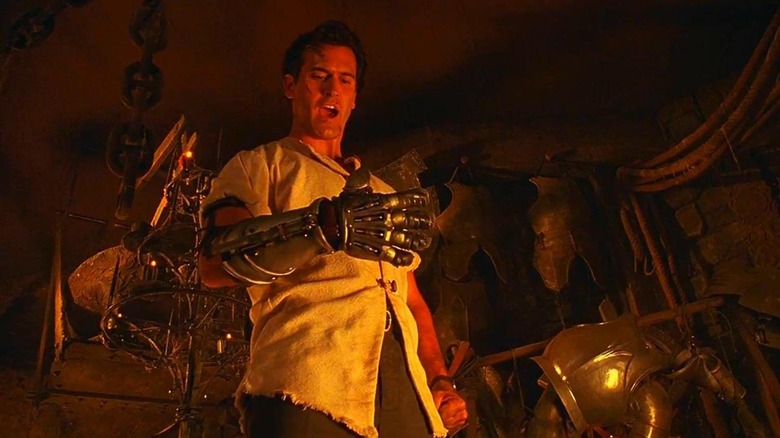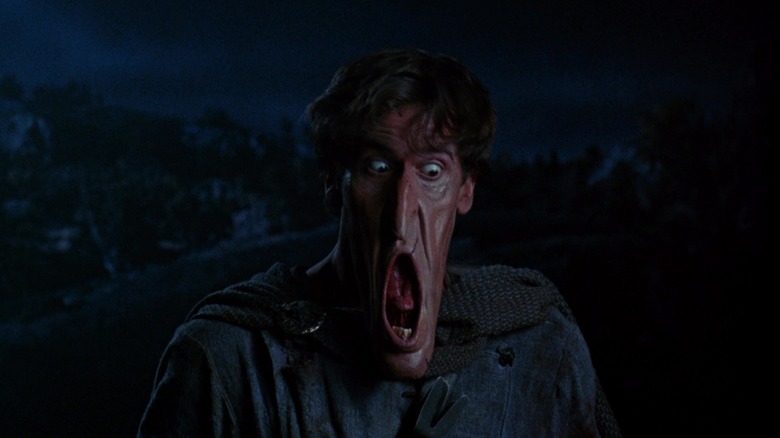Why Sam Raimi’s Army Of Darkness removed Evil Dead from its title

The journey to the “Army of Darkness” is a bit circuitous, so follow me for a moment.
Sam Raimi’s rise to fame is a source of inspiration for all ambitious young filmmakers who don’t hesitate to freeze their butts off in isolated cabins, dousing their friends with red corn syrup. The making of “The Evil Dead” is a tale well known to horror fans around the world. The young filmmaker, along with his actor buddy Bruce Campbell, wanted to make a horror film, but had no money to do so, being working-class kids from Detroit. He and Campbell begged just about everyone they knew for money and eventually scraped together $375,000, just enough to make a scary, bloody movie about a cabin in the woods. They shot on 16mm film with rented cameras.
The film made its way to the screens and grossed a whopping $2.4 million. Overseas, it became a notorious sensation, grossing $27 million (!). Raimi was on his way. In 1987, he energetically directed a sequel/remake of “The Evil Dead” entitled “Evil Dead 2: Dead By Dawn”. It had the same story as the first one, and Campbell still played the lead role, but it was more comical – downright sillier – than the first one. “Evil Dead 2” was made for an extravagant $3.5 million.
Unfortunately, “Evil Dead 2” didn’t make a splash like the first, grossing only $5.9 million. Critics loved it, and horror nerds consider it one of the best films of all time, but technically it was a bomb. No one cared that they were both slowly making their fortunes from home video.
That’s why the next film, 1993’s “Army of Darkness,” wasn’t called “Evil Dead 3.” In a 1992 issue of Cinefantastique magazine, Sam Raimi’s longtime producer Robert Tapert talked about “Army of Darkness” and how the “Evil Dead” films proved detrimental, from a marketing standpoint. “Army of Darkness” was distributed by Universal Pictures, a major studio, and they wanted the “Evil Dead” associations removed from the title.
Universal Pictures wanted to distance Army of Darkness from the Evil Dead films
“Army of Darkness” will seem surreal to anyone unfamiliar with the “Evil Dead” films, although that’s not necessarily a bad thing. At the end of “Evil Dead 2,” Ash (Campbell) used a book of dark magic to open a portal and suck in all the demons that had spent the movie attacking him. Unfortunately, he was also sucked through the portal and landed – with his Oldsmobile – in the 14th century among the knights and sages. “Army of Darkness” picks up in the 14th century, with Ash now completely insane, demanding that the villagers and medieval leaders find a way to bring him back to 1993. He will eventually have to fight an evil doppelganger and his army of living (rubber) skeletons. It’s one of the funniest films of all time.
Because of its setting and numerous special effects, “Army of Darkness” had to be partly financed by a major studio. Its production cost 11 million dollars. And although it was inexpensive for a film, Universal still wanted to hedge its bets and insisted that the film not be called “Evil Dead 3.” Raimi, in fact, wanted to call it “Medieval Dead”, which is clever, but still too close to “Evil Dead” for comfort. As Tapert says:
“Universal – and they are right to do so – said that the title ‘Evil Dead’ was a disadvantage because, based on the way it performed in theaters, no one saw ‘Evil Dead II’. It was a failure for all intents and purposes – even though the film did very well on video, far exceeding what it did at the box office. So they thought fans would know it was ‘Evil Dead III’ and that the rest of the public would simply see it as “Army of Darkness”.
Fans did, but it seems there weren’t enough knowledgeable and enthusiastic “Evil Dead” fans willing to head to the theater to see the new sequel. “Army of Darkness” only grossed $21.5 million.
Who is the Army of Darkness for?
In 1992, Tapert and Bruce Campbell believed that the title change would actually appeal to a wider audience. The “Evil Dead” films were enjoyed by a cult audience, but the very definition of the term meant the audience was small. Bruce Campbell has said in the past that a blockbuster is a million people seeing a film ten times, and a cult film is ten people seeing a film a million times. The latter generally expect home video, so the income is not as high.
At the time, Campbell was happy to agree to Universal’s title change, stating:
“We’re really excited about this. […] The fact that it’s called “The Army of Darkness”, I think it’s good. If more people come to see it, I’m all for it. The first two were limited releases. I think it’s a logical progression…”
Because the film wasn’t a success, it didn’t seem to matter. Raimi could have called it “The Medieval Dead,” and just as many people would have showed up. It’s hard to sell a horror movie that has the tone of a Looney Tunes short, a bizarre time travel plot, and a pace like a hummingbird trapped in a cup of espresso.
Of course, just like the first two films, “Army of Darkness” ended up being a sensation, grossing millions on home video and becoming a cult classic throughout the ages. The irony of it all is that the name “Evil Dead” eventually grew in popularity to the point that it was remade in 2013. The remake cost a modest $17 million, but grossed $97.5 million at the box office. It was followed by a Raimi-designed television series starring “Ash vs. Evil Dead” in 2018, and a sequel remake, “Evil Dead Rise” in 2023. “Evil Dead Burn” is currently in production.
What was once a curse is now a blessing. “Evil Dead” is now a lucrative horror franchise par excellence.






